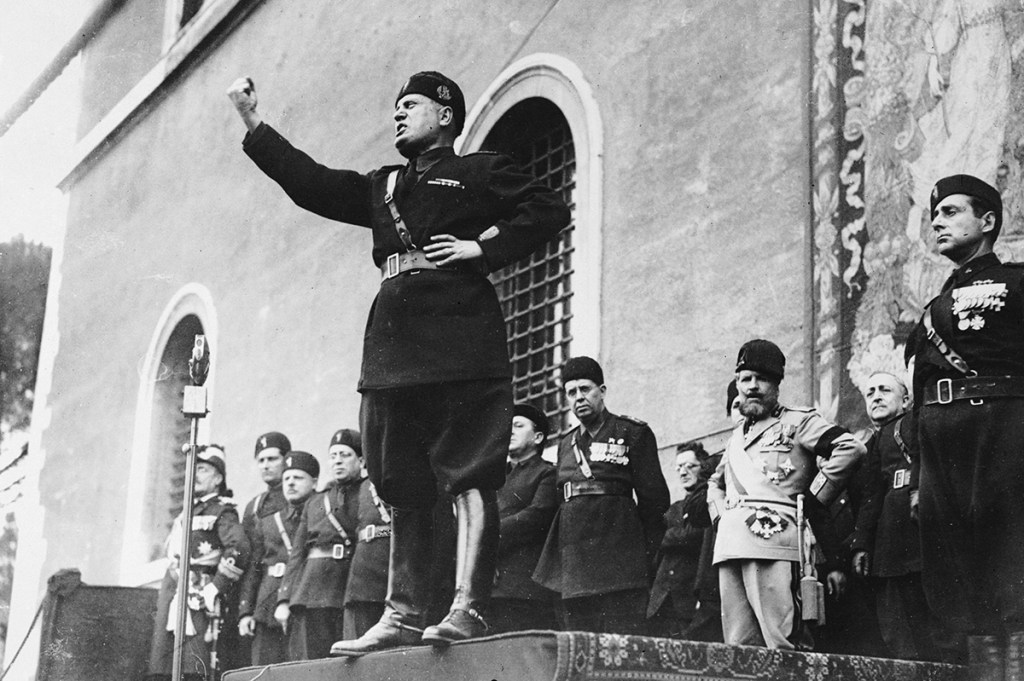In 1919, an obscure political agitator called Benito Mussolini assembled a ragbag of Blackshirt diehards in the Lombard capital of Milan and launched the movement that was to become, two years later, the National Fascist party. The party took its name from the classical Roman symbol of authority — an ax bound in rods, or fasces. Once in power, Mussolini introduced the stiff armed Roman salute after the handshake was deemed fey and unhygienic. At times he wore a richly tasseled fez and thrust out his chin pugnaciously for the cameras.
For all his posturing and demagoguery, Mussolini was widely admired in pre-war Britain, where Lord Rothermere’s Daily Mail routinely carried flattering portraits of him. He was on amiable terms with King George V, moreover, who in 1923 publicly congratulated the dictator on his ‘wise leadership’. Mussolini was seen by many British politicians as a potential ally against Hitler’s Germany. To anyone disgruntled at all by parliamentary democracy, leftist poets, Jazz Age flappers and imagined Judeo-Bolshevik threats, fascism offered a ‘virile’ political alternative.
As the cult of ducismo strengthened, the high priests of fascism hailed Mussolini as a ‘divine Caesar’ figure, and adopted the passo romano, the Latin goose-step, for military parades. A mood of jingoist triumphalism swept Italy after Mussolini invaded Ethiopia in 1935 and incorporated Haile Selassie’s vanquished kingdom into a vast new East African empire, along with Eritrea and Somaliland.
With his rapid Africa conquests, Mussolini won the hypnotized consent of the majority. To his legion female admirers he radiated a manful potency and near-animal allure. He had relations with literally hundreds of women, perhaps ‘as many as 400’ according to one Italian historian. They were brusquely mauled by him under a large ministerial desk or on mattress-like cushions installed for the purpose.
Sex lay at the heart of the fascist cult of physical daring or ardimento. (‘My great lord and beautiful Duce’, a Bologna housewife typically wrote to Mussolini. ‘I have done nothing but trouble you’ — she had sent him a total of 848 letters.) Towards the end of his 23-year dictatorship, facing defeat, Mussolini became addicted to a German-synthesized aphrodisiac pill trademarked Hormovin. Popping this prototype Viagra was in some ways a political act, one that served to prolong the myth of the supremo who never flagged.
Beneath the vainglorious sexual antics and balcony ranting was a man who earnestly dreamed of a second Roman empire for Italy, and dominion over all the Mediterranean. How this pontiff-like Caesar-divinity brought Italy to such a state of ruination yet bedazzled so much of Europe is the subject of this impressive new history, Mussolini’s War.
John Gooch, a Leeds University professor, views Mussolini as deep down a solitary figure, who ‘never believed in experts unless they agreed with him’. Alone and aloof at the head of fascist government, he surrounded himself with reliably complaisant functionaries, who displayed a dog-like obedience and devotion to his warmongering aims.
Unfortunately for Italy, fascist war policy was never linked to a coherent national strategy, argues Gooch. Mussolini relied at first on crowbar-wielding gangs to instill fear in his opponents at home; then came the concentration camps and, in 1938, fascist anti-Semitic legislation which turned Italian Jews overnight into social pariahs. Though Mussolini forbade his daughter to marry a Jew, one of his many mistresses, Margherita Sarfatti, was Jewish. The eagle motifs and suckling she-wolves visible today on fascist-era architecture in Italy are partly Sarfatti’s legacy, as she was the mastermind behind fascism’s pompous celebration of ancient Rome. Sarfatti’s bestselling 1926 biography, Dux, exalted Mussolini as a quasi-sacred manifestation of romanità (‘Romanness’) and the martial Italian race. Yet her name was dirt once Mussolini had hitched his carnival chariot to Hitler’s funeral hearse and, as Gooch writes, committed Italy to Nazi Germany’s ‘anti Semitic cause’.
Most historians agree that Mussolini greeted Hitler’s rise to power in 1933 with suspicion. A racial dogma that glorified blond northern Europeans conflicted somewhat with the Mediterranean cult of romanità. To many Italians, Hitler looked unappealingly furtive and rat-like beside their grandly uniformed Dux. But Mussolini’s decision to intervene in the Spanish Civil War in 1938 lethally allied him to the Führer, as it put him on Germany’s side in the anti-communist ‘crusade’ waged by General Franco.
Mussolini was indisputably the weaker partner in the Nazi-fascist Pact of Steel signed in 1939; yet he resented the imputation that Italian anti-Semitism was the price of friendship with Germany. A latent tension had always existed in Italy between fascism and Italian Jewry. Zionists, in particular, were resented by Mussolini as a self-regarding, supranational sect, inimical to the sturdy Blackshirt bond of race and nation. In 1939, while addressing a fascist convention in Bologna, he lambasted Jews as ‘miserable deadweights’; from there it was a short step to eliminating them.
As the war progressed, Mussolini became disastrously ‘ever more in hock to Nazi Germany’, writes Gooch. Axis allies, such as King Boris III of Bulgaria (who was King Victor Emmanuel III of Italy’s son-in-law), cravenly participated in Hitler’s assault on Greece and Yugoslavia. The Duce’s ill-advised invasion of Greece in October 1940, however, ended in humiliation when the Italians withdrew in a disorderly rout across the Epirus mountains. In North Africa, the dictator fared even more disastrously. In a mighty blow to Italian morale, he was trounced at Tobruk in January 1941 by Britain’s Desert Army.
In Gooch’s lucid analysis, Mussolini clung stubbornly to the belief that war might toughen and invigorate the Italian people. In the summer of 1941, accordingly, with the Vatican’s blessing, he sent 230,000 Italian troops to Russia after Hitler had attacked his unsuspecting ally Joseph Stalin. The Eastern Front proved a severe trauma for the Italian soldiers. Stranded without leadership in sub-zero temperatures, an estimated 43,580 men died during the chaotic retreat of January 1943 and were left unburied on the steppe’s frozen immensity.
Among the Italian officers who managed to return was Nuto Revelli, whose 1946 account of the Russia debacle, Mai Tardi (Never Again), Gooch clearly admires. His face disfigured by frostbite, Revelli scorned fascist generals who even at the war’s end spoke of the nobility of the Blackshirt cause. His book is a classic to rank with All Quiet on the Western Front. Gooch ends his ever more woeful account on September 8, 1943, when Field Marshal Badoglio announced an Armistice with the Allies, and Mussolini’s days apparently were numbered. Fascist party headquarters were set ablaze and the fasces insignia machine-gunned from the front of buildings. Angry crowds in some cities prevented firemen from reaching the cathartic pyre. The worst fascist offenders went into hiding; it was their turn now to be hunted.
While the Allies hurried to send in troops to occupy Italy, they were not fast enough. Hitler having swiftly commandeered key points in the north, Italy was effectively left cut in two: south of Naples, under the Americans and the British; north of Naples, under the Germans. On September 12, Mussolini was rescued from his jail in the Apennines by a team of crack German parachutists and hurriedly installed as head of Italy’s new Nazi-fascist republic. A ruthless new ‘Italian’ government was set up at Salò on the shores of Lake Garda, with the Duce as the Führer’s increasingly unhappy lapdog. Italians had not been liberated from the Nazi-fascist war machine after all.
Mussolini’s War, diligently researched if at times indifferently written (‘Starace was privileging loyalty, whereas Bocchini was prioritizing reality’), offers an exceptionally detailed portrait of the Duce as warmonger. Gooch is among the first historians outside Italy to consider fascism solely through the lens of Mussolini’s prolonged and unwinnable war. It may be fashionable these days to claim Mussolini as a fundamentally decent fellow, led astray by Hitler. Understandably most Italians wish to view themselves as brava gente — good people — so they prefer to blame Hitler both for Mussolini’s murderous anti-Semitism and the calamitous Russia campaign.
Gooch, though, is not so indulgent. Thousands of Italians had lost their lives to one man’s titanic martial ambitions. Vengeance, when it came, was squalid. On April 28, 1945, 75 years ago, Benito Mussolini was executed by Italian partisans and strung up by his feet for all to see in a square in Milan. The tinpot Caesar was no more.
This article was originally published in The Spectator’s December 2020 US edition.

























